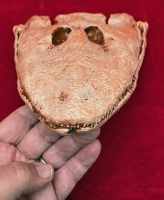
Tiktaalik
Transitional Form from
Bony Fish to Tetrapods
Devonian About 375 MYA
Tiktaalik is a monospecific genus of extinct sarcopterygian (lobe-finned fish) from the Late Devonian Period, about 375 Mya (million years ago), having many features akin to those of tetrapods (four-legged animals). Tiktaalik is estimated to have had a total length of 1.25–2.75 metres (4.1–9.0 ft). The first Tiktaalik fossils were found in 2004 on Ellesmere Island in Nunavut, Canada. and quickly recognized as a transitional form.
Tiktaalik is a non-tetrapod member of Osteichthyes (bony fish), complete with scales and gills—but it has a triangular, flattened head and unusual, cleaver-shaped fins. Its fins have thin ray bones for paddling like most fish, but they also have sturdy interior bones that would have allowed Tiktaalik to prop itself up in shallow water and use its limbs for support as most four-legged animals do. Those fins and other mixed characteristics mark Tiktaalik as a crucial transition fossil, a link in evolution from swimming fish to four-legged vertebrates. This and similar animals might be the common ancestors of all vertebrate terrestrial fauna: amphibians, reptiles, birds and mammals.
The last photo is of an original Tiktaalik showing many details. You are only buying the replica skull.
See https://en.wikipedia.org/wiki/Tiktaalik for greater details.
resin
9" long, 7"wide, 2" thick
Item 4030
Category: Replicas
Type: Skulls
Phylum: Vertebrates
Class: Fish
MORE PHOTOS:




Now Over 1,000 Items!
PrehistoricStore.com offers the largest selection of replica fossils and other fossil-related products anywhere in the world!
Download a Full Catalog (3MB PDF)
OVER 260 PAGES OF REPLICAS AND MORE!
